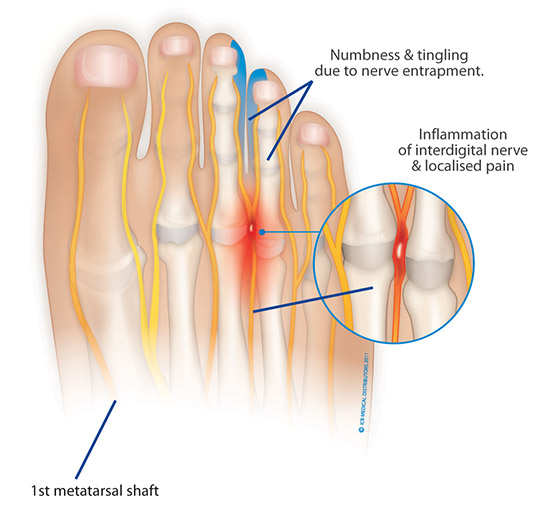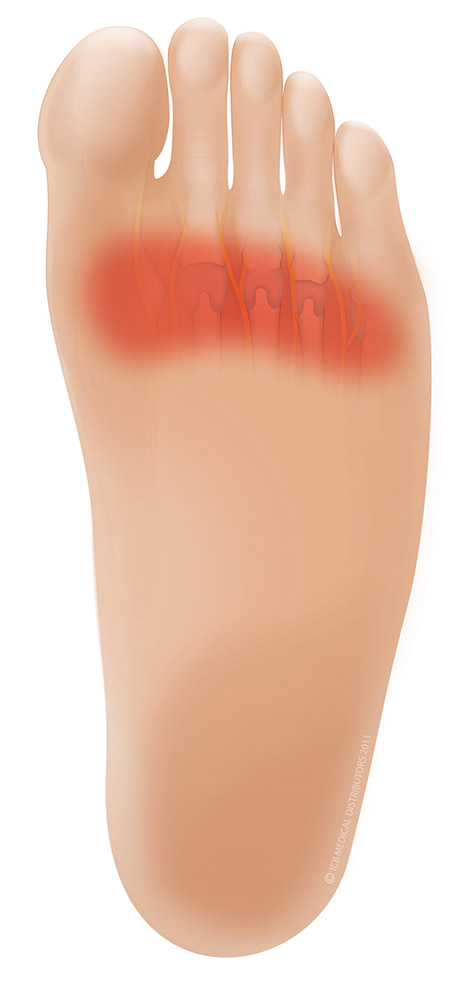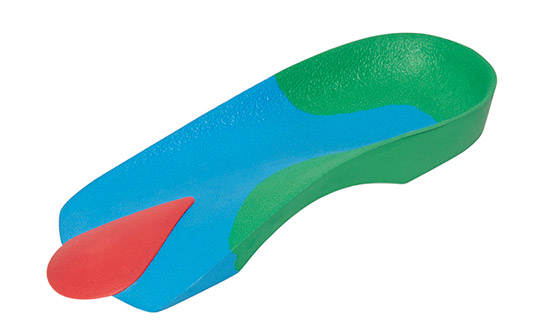Metatarsalgia is a general term used to describe a painful condition in the metatarsal region of the foot (often referred to as the ‘ball of the foot’. Pain associated with metatarsalgia is often experienced under the 2nd, 3rd or 4th metatarsal heads.
Differential diagnosis of metatarsalgia is Mortons Neuroma which exhibits more localised pain as the interdigital nerve is entraped between the metatarsal heads. Mortons Neuroma can also be extremely painful.
Metatarsalgia is a common condition that can be treated simply and effectively. If left untreated it can be debilitating to sufferers.
Biomechanical Aetiology
An underlying cause of Metatarsalgia and Mortons Neuroma is excessive pronation. Excessive pronation can over time cause weakening of the soft tissue structures resulting in ligamentous laxity and sometimes muscle wastage. As the foot pronates the metatarsals plantarflex and rotate resulting in shearing forces on the forefoot structures and loss of the transverse arch, causing pressure and pain to be experienced.
If left untreated, metatarsalgia can lead to the development of Mortons Neuroma. As the foot continues to pronate, the metatarsals plantarflex and rotate, causing the interdigital nerve to become entrapped between the metatarsal heads – which can cause intense localised pain at the site of the nerve impingement.
Symptoms
Metatarsalgia is most commonly characterized by a burning pain in the ball of the foot. Some patient’s describe the pain as being like a stone bruise. This condition often restricts patient’s mobility, or length of time they can be standing or walking, due to the intense pain and discomfort that can be experienced.
Mortons Neuroma generally exhibits more localized pain, at the site of the nerve impingement. It is generally the result of prolonged compression of the interdigital nerve (most commonly between the third and fourth toes), causing irritation and possibly enlargement of the nerve. Sufferers often experience numbness and pain in the affected area.
Treatment
As most patient’s exhibiting symptoms of Metatarsalgia generally pronate excessively, orthotics with a metatarsal dome added to the dorsal surface should be prescribed to realign the subtalar joint to the neutral position, which reduces the plantarflexion and rotation of the metatarsals. The metatarsal dome added to the orthotic assists with lifting the dropped metatarsals, and restoring the transverse arch, thus relieving the pain and discomfort.
Patients suffering from a Mortons Neuroma will also benefit from wearing orthotics, as much of the pressure being placed on the interdigital nerve will be relieved by correcting pronation and restoring the foot to the subtalar neutral position, in combination with the metatarsal dome that assists by lifting and spreading the metatarsal heads, causing less compression of the nerve.
Additional Treatment
Sometimes additional treatment methods can be used in conjunction with ICB Orthotic therapy to ensure long term treatment success. Such treatments include:
- Foot joint mobilizations: to ensure the bones and joints are correctly aligned.
- Acupuncture: particularly useful in providing quick short-term pain relief of Mortons Neuroma.
- Wearing shoes with increased width in the toe box – tight fitting footwear should be avoided.
Head Office
Kirrawee NSW 2232
AUSTRALIA




